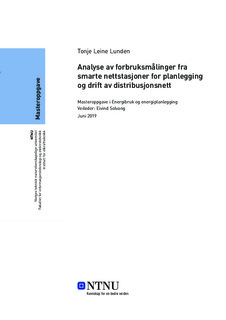Analyse av forbruksmålinger fra smarte nettstasjoner for planlegging og drift av distribusjonsnett
| dc.contributor.advisor | Solvang, Eivind | |
| dc.contributor.author | Lunden, Tonje Leine | |
| dc.date.accessioned | 2019-10-16T14:00:35Z | |
| dc.date.available | 2019-10-16T14:00:35Z | |
| dc.date.issued | 2019 | |
| dc.identifier.uri | http://hdl.handle.net/11250/2622624 | |
| dc.description.abstract | Frem til i dag har nettselskapene hatt lite detaljert informasjon om belastningsvariasjoner i distribusjonsnettet. Smarte nettstasjoner og AMS på kundenivå kan gjøre det enklere for nettselskapene å dimensjonere ulike nettkomponenter. Lyse Elnett har i forbindelse med prosjektet Smarte nett Stavanger bistått med kvantitative forbruksdata fra ulike nettstasjoner i Stavanger sentrum. Nettstasjonene er utstyrt med nytt måleutstyr og fjernstyrte brytere, som kan overvåkes og fjernstyres fra driftssentralen. Formålet med denne oppgaven har vært å se på hvilket potensial forbruksmålinger fra nettstasjoner har for planlegging og drift av distribusjonsnettet. I denne oppgaven har det blitt beregnet timesforbruk for tre ulike nettstasjoner basert på generelle lastprofiler på kundenivå. Beregnet forbruk har blitt sammenlignet med målt forbruk fra nettstasjonene. Det er innhentet temperaturdata fra Meteorologisk institutt for å tilpasse beregnet forbruk til målt forbruk i 2018. Resultatene viste for to av nettstasjonene at beregningene ikke klarer å gjenskape variasjonene i det målte forbruket. Derimot viste beregningene et godt bilde av forbruksvariasjonene for den siste nettstasjonen. Mer nøyaktig kundeinformasjon vil føre til at beregningene kan bli mer presise. Videre er det beskrevet en metode for automatisk oppdatering av forbruksprofiler fra ulike nettstasjoner. Her vil inngangsdata være temperaturmålinger og forbruksmålinger fra nettstasjonene. Unike forbruksprofiler for hver enkelt nettstasjon kan bli generert. Å implementere et verktøy for en slik automatisering i nettselskapene vil medføre økt kunnskap om forbruksvariasjonene for nettstasjoner med gitte kundesammensetninger. Tap ved ulike delepunkt i et ringnett har blitt undersøkt, med utgangspunkt i timesmålinger av forbruk fra de ulike nettstasjonene. Årlig tapskostnad ved å kjøre samme delepunkt hele året sammenlignet med å velge delepunktet med minst tap i ringnettet hver time utgjorde minimale forskjeller. Sett opp mot hvor ofte bryterne må kobles om for å realisere den sistnevnte strategi vil det føre til stor slitasje på bryterne og dermed store investeringskostnader for nye brytere. Det er derfor anbefalt at nettselskapene vurderer alternative strategier. Dette kan for eksempel være et delepunkt for ukedager og et for helg, eller spesifikke delepunkt for ulike sesonger. | |
| dc.description.abstract | Until today the DSOs have had little detailed information on load variations in the distribution network. Smart MV/LV substations and smart meters at customer level can make it easier for the DSOs to dimension different network components. A Norwegian DSO (Lyse Elnett) has provided quantitative consumption data from MV/LV substations in Stavanger, related to the project 'Smarte nett Stavanger'. The substations are equipped with new measuring equipment and remote-controlled switches, which can be monitored and remotely controlled from the operating center. The purpose of this task has been to investigate what potential consumption measurements from substations have for the planning and operation of the distribution network. In this task, hourly consumption has been calculated for three different substations based on general load profiles at the customer level. The calculated consumption has been compared to measured consumption from the substations. Temperature data has been obtained from the Norwegian Meteorological Institute to adjust the calculated consumption to measured consumption in 2018. The results showed for two of the substations that the calculations are unable to recreate the variations in the measured consumption. On the other hand, the calculations recreated the consumption variations for the last substation. More accurate customer information will make the calculated consumption more accurate. Furthermore, a method is described for automatically updating consumption profiles from different substations. The input data will be temperature measurements and consumption measurements from the substations. Unique consumption profiles for each substation can be generated. Implementing such a tool in the DSOs will lead to increased knowledge about the consumption variations for substations with given customer compositions. Based on consumption measurements from the various substations, electrical losses at various points of disconnetion in a ring network have been investigated. The annual cost of loss by having the same point of disconnection throughout the year, compared to choosing the point of disconnetion with the smallest loss in the ring network each hour resulted in minimal differences. Faced with how often the switches need to be reconnected to realize the last strategy, this will wear the switches and lead to large investment costs for new switches. It is therefore recommended that the DSOs consider other strategies. An example can be to have specific points of disconnection for weekdays and weekends, or for different seasons. | |
| dc.language | nob | |
| dc.publisher | NTNU | |
| dc.title | Analyse av forbruksmålinger fra smarte nettstasjoner for planlegging og drift av distribusjonsnett | |
| dc.type | Master thesis |
Tilhørende fil(er)
Denne innførselen finnes i følgende samling(er)
-
Institutt for elkraftteknikk [2468]
